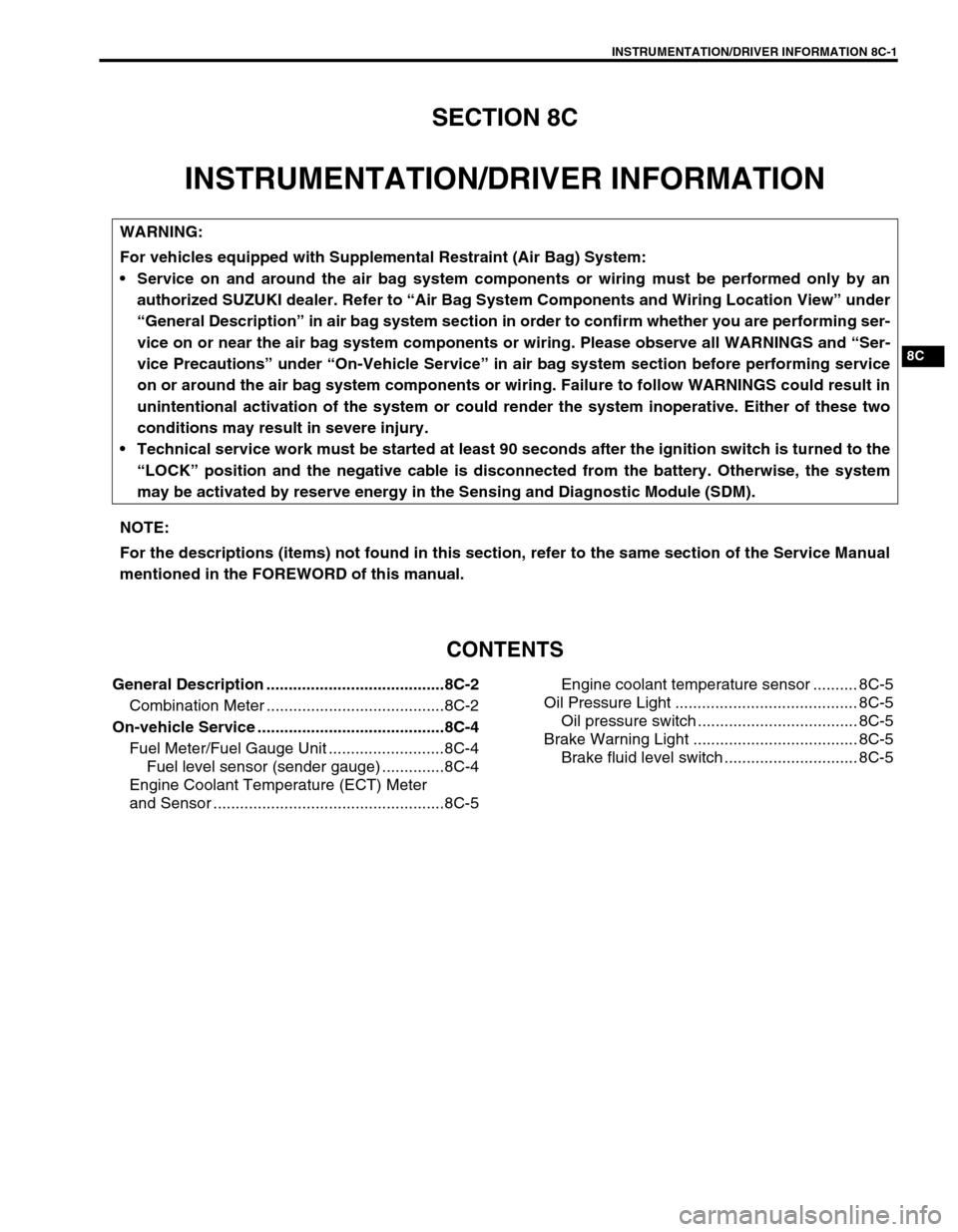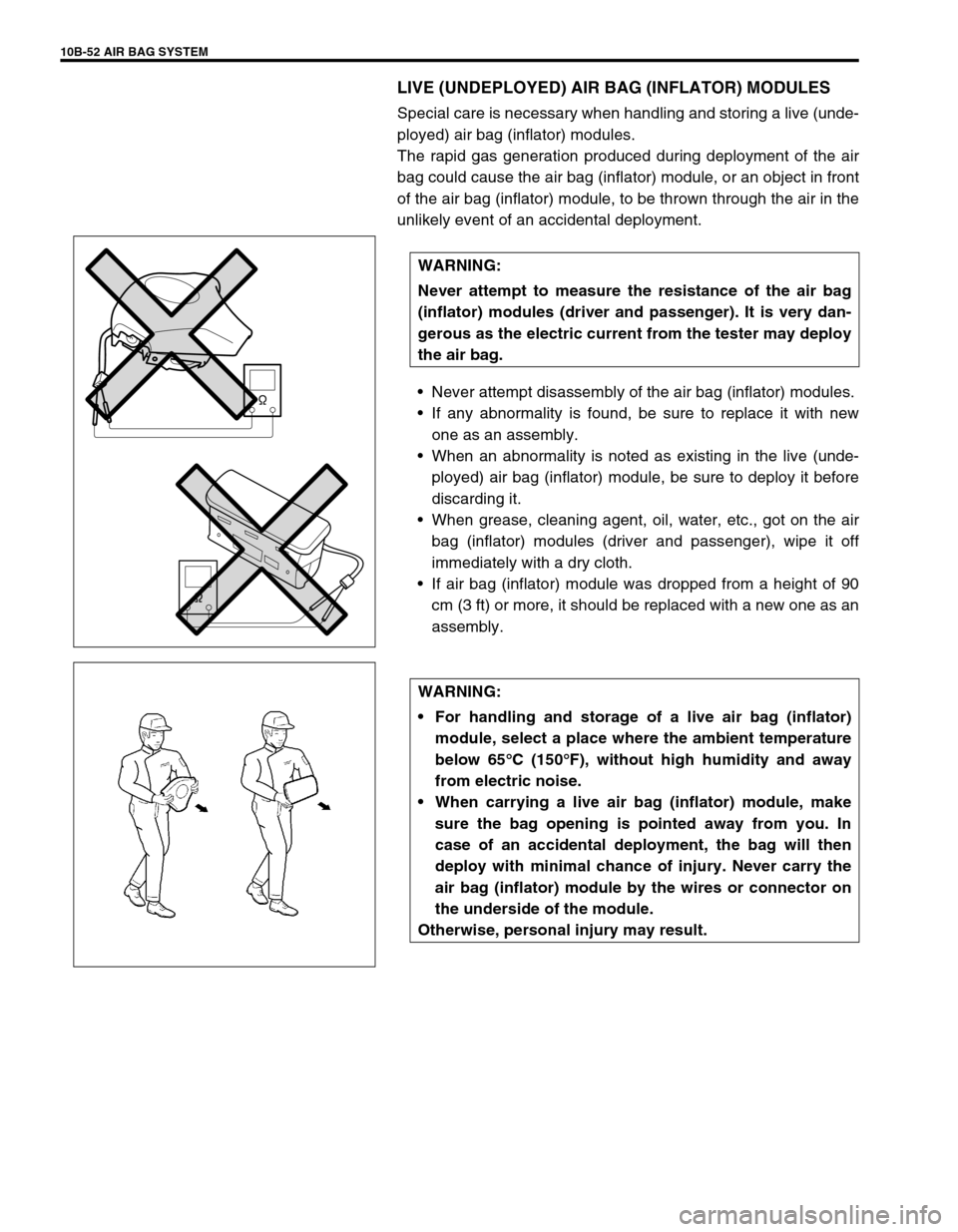Page 512 of 656

INSTRUMENTATION/DRIVER INFORMATION 8C-1
8C
SECTION 8C
INSTRUMENTATION/DRIVER INFORMATION
CONTENTS
General Description ........................................8C-2
Combination Meter ........................................8C-2
On-vehicle Service ..........................................8C-4
Fuel Meter/Fuel Gauge Unit ..........................8C-4
Fuel level sensor (sender gauge) ..............8C-4
Engine Coolant Temperature (ECT) Meter
and Sensor ....................................................8C-5Engine coolant temperature sensor .......... 8C-5
Oil Pressure Light ......................................... 8C-5
Oil pressure switch .................................... 8C-5
Brake Warning Light ..................................... 8C-5
Brake fluid level switch .............................. 8C-5
WARNING:
For vehicles equipped with Supplemental Restraint (Air Bag) System:
Service on and around the air bag system components or wiring must be performed only by an
authorized SUZUKI dealer. Refer to “Air Bag System Components and Wiring Location View” under
“General Description” in air bag system section in order to confirm whether you are performing ser-
vice on or near the air bag system components or wiring. Please observe all WARNINGS and “Ser-
vice Precautions” under “On-Vehicle Service” in air bag system section before performing service
on or around the air bag system components or wiring. Failure to follow WARNINGS could result in
unintentional activation of the system or could render the system inoperative. Either of these two
conditions may result in severe injury.
Technical service work must be started at least 90 seconds after the ignition switch is turned to the
“LOCK” position and the negative cable is disconnected from the battery. Otherwise, the system
may be activated by reserve energy in the Sensing and Diagnostic Module (SDM).
NOTE:
For the descriptions (items) not found in this section, refer to the same section of the Service Manual
mentioned in the FOREWORD of this manual.
Page 513 of 656
8C-2 INSTRUMENTATION/DRIVER INFORMATION
General Description
Combination Meter
1. Tachometer 8. Multifunction indicator light 15. Charge warning light
2. Speedometer 9. Turn signal pilot light (RH) 16. Brake fluid level, parking brake and EBD warning light
3. Fuel level meter 10. AIR BAG warning light 17. POWER indicator light (A/T vehicle only)
4. Engine coolant temperature meter 11. O/D OFF light (A/T vehicle only) 18. CRUISE indicator light
5. Turn signal pilot light (LH) 12. Fasten seat belt light (if equipped) 19. Immobilizer warning light (if equipped)
6. 4WD indicator 13. High beam light 20. Shift position indicator (A/T vehicle, if equipped)
7. ABS warning light 14. Engine oil pressure warning light
Page 516 of 656
INSTRUMENTATION/DRIVER INFORMATION 8C-5
Engine Coolant Temperature (ECT) Meter and
Sensor
Engine coolant temperature sensor
REMOVAL AND INSTALLATION
Refer to “ECT SENSOR” in Section 6E2.
Oil Pressure Light
Oil pressure switch
REMOVAL AND INSTALLATION
Refer to “OIL PRESSURE CHECK” in Section 6A2.
Brake Warning Light
Brake fluid level switch
INSPECTION
Use an ohmmeter to check switch for continuity.
If found defective, replace switch (reservoir).
Brake fluid level switch specification
OFF position (float up) : No continuity
ON position (float down) : Continuity
Page 629 of 656

10B-52 AIR BAG SYSTEM
LIVE (UNDEPLOYED) AIR BAG (INFLATOR) MODULES
Special care is necessary when handling and storing a live (unde-
ployed) air bag (inflator) modules.
The rapid gas generation produced during deployment of the air
bag could cause the air bag (inflator) module, or an object in front
of the air bag (inflator) module, to be thrown through the air in the
unlikely event of an accidental deployment.
•Never attempt disassembly of the air bag (inflator) modules.
•If any abnormality is found, be sure to replace it with new
one as an assembly.
•When an abnormality is noted as existing in the live (unde-
ployed) air bag (inflator) module, be sure to deploy it before
discarding it.
•When grease, cleaning agent, oil, water, etc., got on the air
bag (inflator) modules (driver and passenger), wipe it off
immediately with a dry cloth.
•If air bag (inflator) module was dropped from a height of 90
cm (3 ft) or more, it should be replaced with a new one as an
assembly. WARNING:
Never attempt to measure the resistance of the air bag
(inflator) modules (driver and passenger). It is very dan-
gerous as the electric current from the tester may deploy
the air bag.
WARNING:
For handling and storage of a live air bag (inflator)
module, select a place where the ambient temperature
below 65°
°° °C (150°
°° °F), without high humidity and away
from electric noise.
When carrying a live air bag (inflator) module, make
sure the bag opening is pointed away from you. In
case of an accidental deployment, the bag will then
deploy with minimal chance of injury. Never carry the
air bag (inflator) module by the wires or connector on
the underside of the module.
Otherwise, personal injury may result.
Page 631 of 656

10B-54 AIR BAG SYSTEM
DEPLOYED AIR BAG (INFLATOR) MODULE AND ACTI-
VATED SEAT BELT PRETENSIONER
Refer to the procedure described under “DEPLOYED AIR BAG
(INFLATOR) MODULE AND ACTIVATED SEAT BELT PRETEN-
SIONER DISPOSAL” in this section for disposal. WARNING:
For handling and storage of a live seat belt preten-
sioner, select a place where the ambient temperature
below 65°
°° °C (150°
°° °F), without high humidity and away
from electric noise.
Never carry the seat belt pretensioner by the wire or
connector of the pretensioner.
When placing a live seat belt pretensioner on the work-
bench or other surface, be sure not to lay it with its
exhaust hole (1) provided side facing down. It is also
prohibited to put something on its face with an exhaust
hole (1) or to put a seat belt pretensioner on top of
another.
Otherwise, personal injury may result.
WARNING:
The air bag (inflator) module and seat belt pretensioner
immediately after deployment/activation is very hot.
Wait for at least 30 minutes to cool it off before pro-
ceeding the work.
Do not apply water, oil, etc. to deployed air bag (infla-
tor) module and to activate seat belt pretensioner.
After an air bag (inflator) module has been deployed,
the surface of the air bag may contain a powdery resi-
due. This powder consists primarily of cornstarch
(used to lubricate the bag as it inflates) and by-prod-
ucts of the chemical reaction. As with many service
procedures, gloves and safety glasses should be
worn.
Wash your hands with mild soap and water after com-
pleting the work.
Page:
< prev 1-8 9-16 17-24